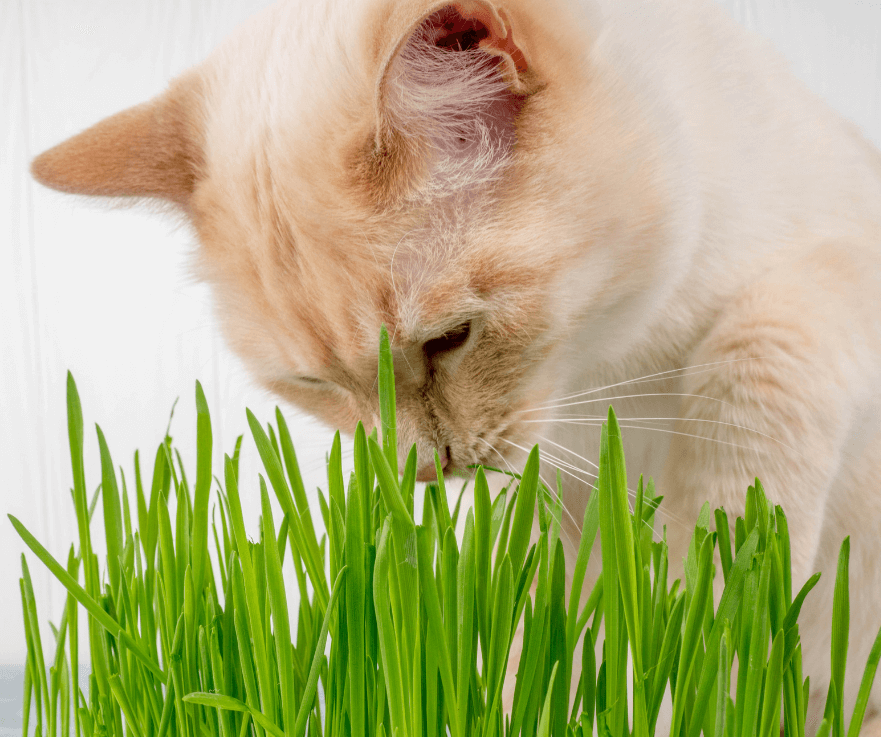All You Need to Know About Cat Grass and Catmint

Cat grass and catmint, otherwise known as catnip, are the two plants that come to mind when we talk about plants for cats. Unsurprisingly, our innately independent cats seek their own way to heal themselves, and these plants help them do that. Though these plants vary vastly, they both offer healing properties to cats. We tell you all you need to know about cat grass and catmint, and self healing in cats.
Cat Grass
Rather than a specific species, cat grass is a collective name for grasses that grow from barley, oat, wheat and rye seeds. These grasses are rich in vitamins, and appeal to humans for these properties. Wheatgrass, a popular addition to green smoothies, contains vitamins A, Bs, C, E and K, and calcium, iron, magnesium and chlorophyll. Cats are obligate carnivores, meaning they thrive on a diet of meat protein and fats. But they can still draw nutritional benefit from the occasional snack of cat grass.
Veterinarians and researchers can’t say for certain why cats eat cat grass. But it is widely accepted that cat grass acts as a laxative and induces vomiting. Cats ingest cat grass to free their stomachs of stubborn furballs and undigestible objects. The additional nutrients are a bonus.
Self-medicating is an instinct we can add to the skill set of these independent creatures. Dr. Lori Teller, Clinical Associate Professor of the Department of Small Animal Clinical Sciences at the Texas A&M College of Veterinary Medicine, says ‘the chlorophyll contained in the grass could serve as a mild pain reliever’.
But there may be another reason cats eat cat grass. ‘Cat grass is not a required part of a cat’s diet if the food they are eating is well-balanced, but it is something that many cats enjoy,’ says Teller. Rather than forcing down a shot of wheat grass for its nutrient-dense goodness, they just like the taste.
Our cats’ lives are a far cry from those of their ancestors. The act of seeking out and eating cat grass may be a ‘source of environmental enrichment’ for our felines, Teller says. An added bonus is that it helps to freshen a cat’s breath. And not only is it good for your kitty cat – it’s safe for dogs, too.
Growing cat grass is easy, indoors or outside. A packet of cat grass seeds and a pot filled with good soil is all you need. Follow the directions on the back of the seed packet. You can also buy pots of growing cat grass from your local plant nursery. It’s easy to care for, and saves exposing your feline to any chemicals and bacteria outside. It may also deter them from inadvertently eating houseplants that pose a real threat to them. Read 10 Common Household Hazards for Cats for more information on dangerous plants and other household hazards for your cat.
Teller advises caution if you notice your cat eating an excessive amount of cat grass. Take a trip to the vet to rule out any nutritional or health issues.
Catmint
Catmint, or nepeta cataria, is a perennial herb in the mint family, famed for its ability to attract cats. It is indeed a type of mint, but catmint contains the chemical compound, nepetalactone, giving rise to its other name, catnip.
The nepetalactone found in catmint is responsible for attracting cats by activating their opioid systems. It isn’t addictive or destructive to a cat’s health. It isn’t a herb cats ingest, like cat grass. Cats will lick or chew on catmint to release more of its aroma. Located in the roof of a cat’s mouth is a duct called the vomeronasal organ. It is part of a cat’s olfactory system and allows them to detect smell through their mouths.
Biochemist Masao Miyazaki, professor at Iwake University in Japan, spent five years studying the effects of nepetalactone on our feline friends. Miyazaki confirms that catmint affects about two thirds of all cats, as well as big cats, including lions, tigers and ocelots. In his study, Miyazaki concludes that cats respond strongly to the compound because it mimics cat pheromones.
Affected felines become relaxed, roll around in the catmint, rub their cheeks, paw playfully at the air, and appear drowsy. Though it only has this affect on sexually mature cats, their response is not sexual in nature.
Natural Bug Repellant
Miyazaki found that cats ‘rolling [in catmint] is rather a functional behaviour’, rather than purely for the elation it brings. Nepetalactone is what is known as an iridoid, meaning it naturally repels insects such as flies, mozzies and bed bugs. Miyazaki believes cats intentionally or instinctively cover themselves in catmint essence to keep bugs away. It is little wonder that cats love the stuff. Nepetalactone doesn’t just allow cats to treat themselves to a short euphoric holiday. Cats also use nepetalactone to rid themselves of the annoyance and stings of insects.
Silver vine, also known as matatabi, also contains nepetalactone. In his study, Miyazaki discovered that silver vine had a better response rate of almost 80%. And 75% of the cats that did not respond to catmint were affected by silver vine. Cats like to chew on the plant stalks, and this is great for their teeth. Matatabi sticks are available at specialty pet shops.
Miyazaki also tested tatarian honeysuckle (considered a weed in Australia) and valerian root. Both plants had a response rate of 50%. Interestingly, the attractant and euphoric effects of nepetalactone occur exclusively on cats. It has little to no effect on other mammals, including us. But it does apparently make a nice aromatic tea.
Add self healing to a cat’s list of impressive attributes. With the help of cat grass and catmint, cats can supplement their diets with vitamins and minerals, and heal themselves from tummy aches. They can enjoy a relaxing, aromatic afternoon roll in the garden when life becomes stressful, and they can keep insects away. Is there anything these truly remarkable creatures cannot do?
